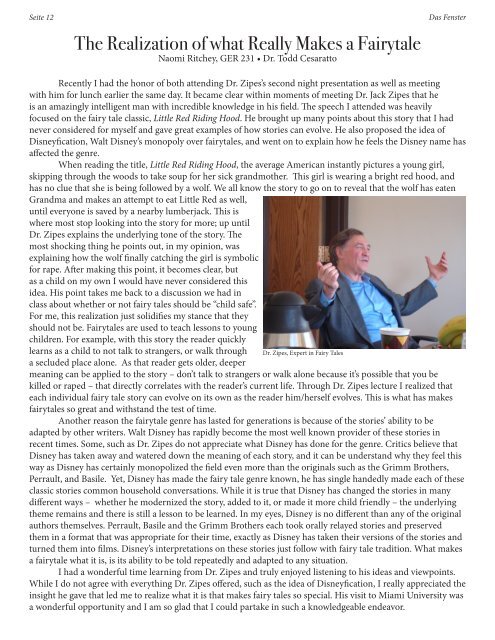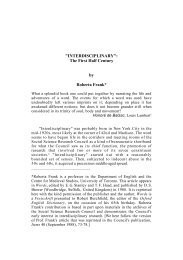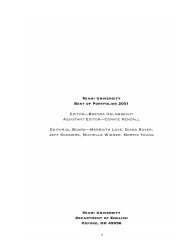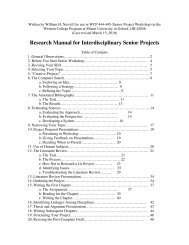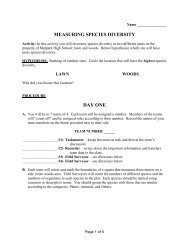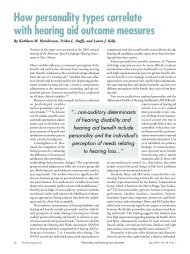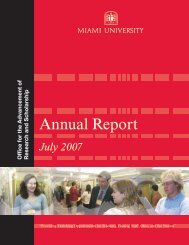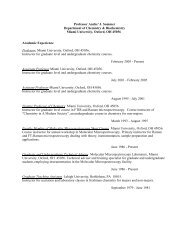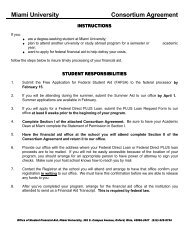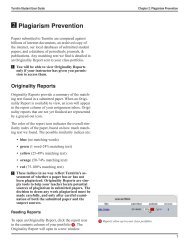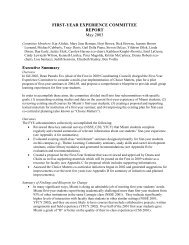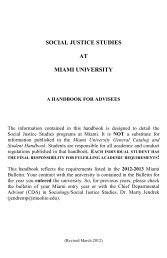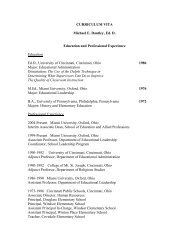DAS FENSTER - units.muohio.edu - Miami University
DAS FENSTER - units.muohio.edu - Miami University
DAS FENSTER - units.muohio.edu - Miami University
Erfolgreiche ePaper selbst erstellen
Machen Sie aus Ihren PDF Publikationen ein blätterbares Flipbook mit unserer einzigartigen Google optimierten e-Paper Software.
Seite 12<br />
The Realization of what Really Makes a Fairytale<br />
Naomi Ritchey, GER 231 • Dr. Todd Cesaratto<br />
Das Fenster<br />
Recently I had the honor of both attending Dr. Zipes’s second night presentation as well as meeting<br />
with him for lunch earlier the same day. It became clear within moments of meeting Dr. Jack Zipes that he<br />
is an amazingly intelligent man with incredible knowledge in his field. The speech I attended was heavily<br />
focused on the fairy tale classic, Little Red Riding Hood. He brought up many points about this story that I had<br />
never considered for myself and gave great examples of how stories can evolve. He also proposed the idea of<br />
Disneyfication, Walt Disney’s monopoly over fairytales, and went on to explain how he feels the Disney name has<br />
affected the genre.<br />
When reading the title, Little Red Riding Hood, the average American instantly pictures a young girl,<br />
skipping through the woods to take soup for her sick grandmother. This girl is wearing a bright red hood, and<br />
has no clue that she is being followed by a wolf. We all know the story to go on to reveal that the wolf has eaten<br />
Grandma and makes an attempt to eat Little Red as well,<br />
until everyone is saved by a nearby lumberjack. This is<br />
where most stop looking into the story for more; up until<br />
Dr. Zipes explains the underlying tone of the story. The<br />
most shocking thing he points out, in my opinion, was<br />
explaining how the wolf finally catching the girl is symbolic<br />
for rape. After making this point, it becomes clear, but<br />
as a child on my own I would have never considered this<br />
idea. His point takes me back to a discussion we had in<br />
class about whether or not fairy tales should be “child safe”.<br />
For me, this realization just solidifies my stance that they<br />
should not be. Fairytales are used to teach lessons to young<br />
children. For example, with this story the reader quickly<br />
learns as a child to not talk to strangers, or walk through<br />
a secluded place alone. As that reader gets older, deeper<br />
Dr. Zipes, Expert in Fairy Tales<br />
meaning can be applied to the story – don’t talk to strangers or walk alone because it’s possible that you be<br />
killed or raped – that directly correlates with the reader’s current life. Through Dr. Zipes lecture I realized that<br />
each individual fairy tale story can evolve on its own as the reader him/herself evolves. This is what has makes<br />
fairytales so great and withstand the test of time.<br />
Another reason the fairytale genre has lasted for generations is because of the stories’ ability to be<br />
adapted by other writers. Walt Disney has rapidly become the most well known provider of these stories in<br />
recent times. Some, such as Dr. Zipes do not appreciate what Disney has done for the genre. Critics believe that<br />
Disney has taken away and watered down the meaning of each story, and it can be understand why they feel this<br />
way as Disney has certainly monopolized the field even more than the originals such as the Grimm Brothers,<br />
Perrault, and Basile. Yet, Disney has made the fairy tale genre known, he has single handedly made each of these<br />
classic stories common household conversations. While it is true that Disney has changed the stories in many<br />
different ways – whether he modernized the story, added to it, or made it more child friendly – the underlying<br />
theme remains and there is still a lesson to be learned. In my eyes, Disney is no different than any of the original<br />
authors themselves. Perrault, Basile and the Grimm Brothers each took orally relayed stories and preserved<br />
them in a format that was appropriate for their time, exactly as Disney has taken their versions of the stories and<br />
turned them into films. Disney’s interpretations on these stories just follow with fairy tale tradition. What makes<br />
a fairytale what it is, is its ability to be told repeatedly and adapted to any situation.<br />
I had a wonderful time learning from Dr. Zipes and truly enjoyed listening to his ideas and viewpoints.<br />
While I do not agree with everything Dr. Zipes offered, such as the idea of Disneyfication, I really appreciated the<br />
insight he gave that led me to realize what it is that makes fairy tales so special. His visit to <strong>Miami</strong> <strong>University</strong> was<br />
a wonderful opportunity and I am so glad that I could partake in such a knowledgeable endeavor.


